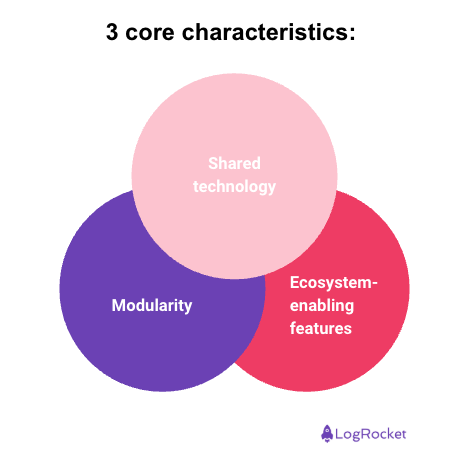Recently, product platforms have emerged as an essential tool for establishing scalable product ecosystems. These platforms serve as core systems, enabling the production of a range of products while encouraging creativity and efficiency.

As a PM, product platforms help you shorten time-to-market and lower costs. Whether you work in the software, hardware, or hybrid sectors, mastering the art of platform management is critical to achieving long-term growth and remaining competitive. Keep reading to learn more about what product platforms are, the benefits of adopting them, and real-world examples.
A product platform is a shared set of technology, procedures, and components that allows the development of a set of related products. Product platforms let you extend your services by standardizing basic features and enabling modularity, while individual products can be tailored to unique client demands.
The concept of “platform as a product” entails considering a platform as a standalone service that may serve both end users and third-party developers. Rather than simply providing an internal framework for product development, the platform is managed and promoted with its own value proposition, usability, and ecosystem-enabling characteristics. For example, Microsoft Azure serves as a product by providing organizations with sophisticated cloud services while allowing developers to build and integrate apps, resulting in a scalable and collaborative ecosystem.
Creating a platform that serves as a product offers the following key benefits:
Product platforms rely on three core characteristics:

Product platforms are created on a common technology stack that supports all the products in the ecosystem, allowing for efficiency and interoperability across offerings. This unified base minimizes duplication of effort and guarantees all products integrate seamlessly.
Platforms are built with interchangeable components, allowing teams to customize, update, or replace functionality without disturbing the overall system. This modularity encourages innovation and flexibility to shifting market demands.
Platforms contain APIs, SDKs, and third-party integration options that facilitate collaboration with other developers and partners. These features enhance the platform’s usability and foster a thriving ecosystem of additional products and services.
To help you better understand what a product platform is, this section outlines the characteristics of one alongside a product and service.
A product is an independent item (either physical or digital) intended to provide certain functionality or value to users. It’s self-contained and interacts directly with users to address specific needs or concerns. For example, the iPhone is a product that combines hardware and software to serve as a personal device for communication, entertainment, and productivity. Its mission is user-centered and independent of other offers.
A product platform allows for flexibility and scalability by acting as a common base for creating various products within a connected ecosystem. It promotes efficiency and consistency by offering shared frameworks, technologies, and components that may be used by a variety of products. For instance, iOS is a product platform that runs a number of Apple products, including the iPhone, iPad, and Apple Watch. It allows app developers to create software that works seamlessly with other devices in the ecosystem.
A service, as opposed to a physical or stand-alone product, provides value through experiences or procedures. It focuses on offering features or results — often intangible — that improve user experience or accomplish certain goals. For example, iCloud is a service that complements Apple products without being a physical entity by enabling customers to save, backup, and synchronize data across Apple devices. Services frequently complement platforms and products to increase their usefulness.
Now that you have the basics down, use these steps to start implementing a product platform:

Analyze existing and prospective products to identify similarities in features, technologies, or user requirements. This core research ensures that the platform focuses on the components that add the most value throughout the ecosystem.
Develop platform-level technology and modular components that can be reused across various products. These components should be adaptable enough to accommodate customization while maintaining consistency in performance and quality.
Include scalability, modularity, and flexibility in the platform’s architecture to allow future expansion and changing market demands. This ensures that the platform is adaptive to new use cases and future technologies.
Regularly improve the platform based on feedback from consumers, product teams, and partner developers. Continuous enhancement ensures the platform’s competitiveness, security, and alignment with stakeholder needs.
Successful companies lean on the concept of platform as a product to build effective user ecosystems. Some of the biggest examples include:
Microsoft Azure represents a platform as a product by providing businesses and developers with a range of cloud-based services such as virtual machines, AI tools, and data storage. Azure’s success stems from its scalability and adaptability, which accommodates both small startups and large companies.
Microsoft Azure’s success can be due to a number of major strategies. One of the most important was to encourage robust third-party developer engagement using comprehensive tools including SDKs, APIs, and a range of pre-built templates.
AWS is a prime example of a product platform created to provide businesses with scalable cloud solutions. It offers a wide range of services, including processing power, database storage, and content delivery, allowing organizations to swiftly develop and expand applications.
AWS’s approach is based on providing a highly flexible and adaptable cloud infrastructure that appeals to both small startups and large organizations. One of the primary drivers of AWS’s success is its emphasis on third-party developer engagement, which includes comprehensive API support, integration options, and developer resources such as AWS Lambda and SDKs.
The iPhone, iPad, and Apple Watch are all built on Apple’s iOS platform, which provides a consistent user experience and functionality across the whole ecosystem. As a platform, iOS has managed to appeal to both end users and developers who create App Store applications.
Apple’s iOS platform has thrived partly due to its emphasis on a flawless user experience, which is backed by significant third-party developer participation. Apple provides clear rules, APIs, and tools like Xcode and App Store Connect to help developers easily create and distribute programs while maintaining a high level of quality and security.
While product platforms are a great tool, they come with their own unique set of challenges.
One of the most difficult aspects of managing a product platform is ensuring consistency across the ecosystem, especially when dealing with various products, third-party connections, and diverse user requirements. Consistency in user experience, design standards, and functionality is vital for ensuring that all products produced on the platform feel coherent and in line with the platform’s brand and values.
Product platforms must strike a balance between flexibility — allowing developers and users to adapt, personalize, and innovate — and the constraints required to assure the platform’s reliability and security. Overly strict constraints can inhibit creativity and limit how the platform can be used or extended, whereas too much flexibility can lead to fragmentation, inconsistency, and security flaws.
Security is important for product platforms that handle sensitive user data, third-party integrations, and scalable services. As platforms expand and incorporate new features, they become more sophisticated and vulnerable to security concerns, such as data breaches, unauthorized access, or weaknesses in third-party integrations.
As product platforms change and grow, managing technological debt becomes a major concern. Technical debt is the accumulation of inefficient design or code errors made during platform development, frequently owing to time restrictions or the demand for quick answers.
To effectively solve the issues of product platform management, several key solutions can be applied to assure scalability, consistency, and long-term success:
Product platforms are an essential part of modern product management, providing scalable, adaptable ecosystems that drive innovation and efficiency. By distinguishing between goods, services, and platforms, you can effectively market platforms as standalone solutions, opening up new growth prospects. Good luck, and comment with any questions!
Featured image source: IconScout

LogRocket identifies friction points in the user experience so you can make informed decisions about product and design changes that must happen to hit your goals.
With LogRocket, you can understand the scope of the issues affecting your product and prioritize the changes that need to be made. LogRocket simplifies workflows by allowing Engineering, Product, UX, and Design teams to work from the same data as you, eliminating any confusion about what needs to be done.
Get your teams on the same page — try LogRocket today.

Most teams fail at autonomy. Learn how clear rules help product teams move faster without micromanagement.

A practical framework for PMs to use AI in ideation without sacrificing judgment, strategy, or decision quality.

A practical five minute revenue estimation method to help product managers compare ideas, drop low impact features, and prioritize smarter.

A practical guide for PMs who want to stop being bottlenecks, delegate smarter, and lead teams effectively with a clear ownership framework.